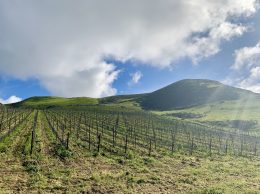Bronzini: 2015 tri-county wine grape crop disappointing

Tom Bronzini
The low-yielding wine grape crop of 2015 was prominent in discussions when grape growers, vintners and financial partners gathered for the Central Coast Insights industry conference at the Allegretto Vineyard Resort in Paso Robles on March 10.
The event came a month after the release of the preliminary California Grape Crush Report that showed tonnage crushed in District 8, which covers the Tri-Counties, down 30 percent from the previous year — a much sharper drop than the statewide decline of 5 percent.
The grape crop on the Central Coast was ambushed by an unusually cool month of May that came just when buds were breaking, a bad thing for flower development and fruit set. When it became known in mid to late summer that the crop would be light, what had been a boring year for spot market brokers turned into a scramble of buyers looking for grapes and bulk wines, Audra Cooper of Turrentine Brokerage said.
William Goebel, bulk wine broker for Turrentine, said Paso Robles cabernet sauvignon that had been trading at $10 to $14 a gallon shot up to $19 to $21 a gallon. Not much is currently available, he said.
The pinot noir harvest in Santa Barbara County was down 49 percent in 2015 after a very large crop in the prior year, Cooper said. Average grower returns per ton for pinot noir grapes in District 8 went up 10.5 percent from $2,646 in 2014 to $2,923 last year, according to the Grape Crush Report.
Returns for all wine grape varieties in District 8 were up a modest 2.4 percent, largely because 90 percent of production is under long-term contracts. That did not nearly make up for the sharp drop in yields, and it was a difficult year with many vineyards not able to deliver all the grapes under contract.
In the Santa Maria Valley, cool-climate syrah took the biggest hit. Bruce Jordan of Reserve Vineyard Management said their clients suffered about a 60 percent decline in the syrah crop.
Trends to watch
Here are some takeaways from conference panelists about the outlook and trends for the regional wine industry:
• Demand for grapes will be high. Vintners are signing or renewing contracts early to secure supplies for the next two to seven years.
• Some national brands with huge case production are looking to Paso Robles and Santa Barbara County to support their fast-growing programs.
Wayne Donaldson, winemaker at Josh Cellars, a brand that has zoomed from 20,000 cases when it was acquired by Deutsch Family Wines in 2011 to over a million annually, said Central Coast bulk wines make up a significant contribution to its California-appellation blends: about 15 to 20 percent of volume.
“We understand that everyone wants to make money and short crops put pressure on everyone,” he said. “We will pay premiums as a result of that, but long-term, stable, steady growth of supply for us is very important.”
Donaldson said the brand is locking up three- and four-year deals for bulk wines from grapes grown efficiently for its product line selling at around $15 a bottle.
Melissa Stackhouse, director of winemaking at Meiomi, said its 700,000 cases of coastal California pinot noir are sourced primarily from Monterey, Sonoma and Santa Barbara counties. She said Santa Barbara may account for about 30 percent of the growing brand’s grape buys in years ahead.
• Growers are replacing older vines that are declining in yield with newer stock that is more resistant to drought and salt buildups in the soil. A shift from spur-pruning to cane-pruning of vines is also helping to improve yields.
• Mechanization will play an increasing role at vineyards. There will always be a robust demand for grapes where all pruning, thinning and harvesting is done by hand, and higher prices are built into contracts for them. Large-scale buyers are welcoming mechanization so they can meet their mass market bottle price target. Some vineyards have been replanted to fewer acres, with spacing that allows for the turning radius of mechanical harvesters. Mechanized pruners and canopy thinners are in play.
• Central Coast wineries surveyed by The Silverado Group are dealing with the 2015 grape shortage by bottling more of their wine on hand from previous vintages. Other strategies include raising prices, slowing down marketing, decreasing allocations and negotiating or re-signing grape contracts earlier.
• The 2015 harvest set the stage for an industry reset. The harvest was “super painful,” Doug Wilson, vice president of winery relations at Silverado Investment Management Group, told the gathering, “but what it did for all of us cleaned house in a lot of ways.”
He said it erased a surplus of bulk wines and sent even more grape buyers into long-term contracts that provide stability for growers.
“Although it was painful, I think it was really critical to get everything rebalanced and kind of start off on a new run for the future,” he said.
• Contact Tom Bronzini at [email protected].












